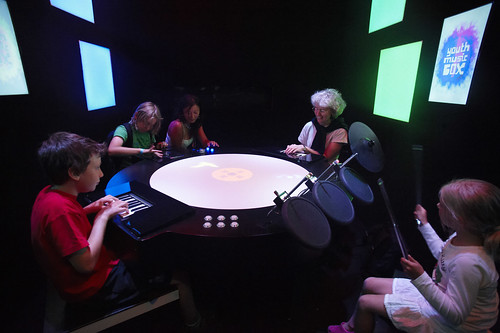Ten minutes. Four or five kids (or adults). Make a song. Go.
That’s the idea behind the Youth Music Box, developed by Silent Studios and Chris O’Shea. (Our friend Chris you may recall from various interactive projects and the blog pixelsumo; he sends this project our way.) The software is build in openFrameworks, the C++-based creative coding environment for artists.
With keys, drums, and yes, even a scratching DJ-style interface, the music box brings together kids for quick music making, inspired by the phenomenon of musical games. The experience is guided by genre, with some effort to make sure whatever they do sounds good, but it’s extraordinary how effective it is at conveying the experience of the successful jam. It’s a bit of a confidence builder, in other words, for a group musical experience, perhaps more so than those ear-splitting, cheap plastic recorder consorts I recall from my youth.
And oh yeah, those kids look super cute once they get rocking out. (See video below.)
Youth Music Box Experience from Silent Studios | Resonate on Vimeo.
All of this raises some fascinating questions, and not always with the answers you might expect. In a normal musical ensemble, you begin sounding like crap, amp up difficulty, and eventually sound something like this – at least as far as coherence goes, assuming you’re not aiming for experimental free jazz. But with the addition of technology, whether musical games or the presets on our favorite synths or the quantization and beat-synced loops of our sequencers, it goes something in reverse. You start out sounding like this, pull apart the mechanisms that make you sound a certain way, and eventually find your way to your own personal approach. (And at some point, you get some of the readers on this site, writing code to produce their own sounds and musical structures line by line.) In fact, one could imagine scaling difficulty of even this particular setup, gradually adding greater musical freedom and taking away the “training wheels” of all the rules-based restrictions that make the results sound a particular way.
Skeptical about the connection of music-based games and actual music making? Think again – even as music education unravels worldwide, games are actually encouraging real music. That revelation was the impetus of the music box project:
Research commissioned by Youth Music found that up to 2.5 million young people in the UK – or 1 million aged between 12 and 18 – have been inspired to progress into ‘real’ music-making because they have played music-based console games.
You got it – they hit those plastic buttons, got inspired, got bored, then decided to go to the real thing. And otherwise, they might have remained passive musical consumers: the game was a gateway drug. Of course, that means that any such interactive experience has to stand up to polished Guitar Hero and Rock Band-style games. But anyone who believes the music games genre has peaked and is on its way out may be dead wrong on many, many levels. On the contrary, this may only be getting started – and the real growth could come in music beyond the realm of games, as people graduate to the unlimited set of possible music experiences.
Chris sends lots more documentation of this project, if you’d like to learn more:
by silent studios and me for uk charity youth music to get kids turned on to music
http://www.vimeo.com/6210259watch some bbc coverage here
http://news.bbc.co.uk/cbbcnews/hi/newsid_8160000/newsid_8168800/8168881.stm
http://news.bbc.co.uk/1/hi/technology/8154449.stmEd.: The video at top doesn’t play outside the UK, because we don’t pay BBC license fees. What, all those Doctor Who videos I bought in the 80s and 90s didn’t make up for it?
here is a press release from roland. the box is ‘powered by roland’
http://www.audioprointernational.com/news/1329/Roland-unveils-Music-Box-for-Youth-Musicsome launch pics
http://www.flickr.com/photos/pixelsumo/sets/72157621466657993/making of pics
http://www.flickr.com/photos/pixelsumo/sets/72157621404410234/this goes into some of the ideas and details about the musical kit
http://musicispower.youthmusic.org.uk/blog/24/youthmusicboxlaunchesatlondonssouthbankcentre/on the website there is a very simplified flash version you can try out on a mini timeline, just click play online 🙂
its quite funny to read these comments on it
http://www.hypebot.com/hypebot/2009/07/youth-music-box-democratizes-music-creation.html
And yes, you can try this yourself and play online! The official site:
http://musicispower.youthmusic.org.uk/youth_music_box/
The production company:
http://www.silentstudios.co.uk/
And Chris’ own site:
Roland is involved, and donated an E-09 Interactive Music Arranger to give kids some toys to explore.
And yes, I did notice a certain kindred spirit in the form of Moldover’s Octamasher. The underlying technology and its results are different, but to me what’s most interesting isn’t the superficial similarity of these projects, but the fact that they array the instruments in a circle. Computer production often simply orients a single person to a screen – not so ideal for collaboration. And even Rock Band and Guitar Hero, like an onstage band, line up artists for a (now nonexitent) audience. Perhaps the circle is about to make a comeback as music restores its social aspect.
Curious to hear other thoughts on these projects as they evolve.
